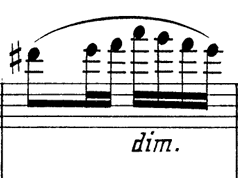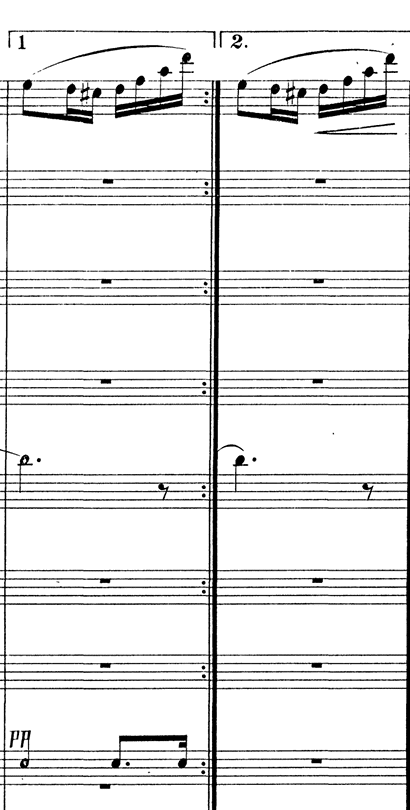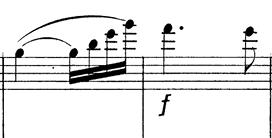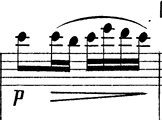It’s been a crazy few months, but I’m happy to finally have some time to return to blogging! We’ll pick up right where we left off in the series on orchestral excerpts, starting with the flute solo in the fourth movement of Antonín Dvořák’s (1841-1904) Symphony no. 8 in G Major, Op. 88, B. 163.
Background Information
Similar to how Beethoven’s Symphony no. 6 in F Major, Op. 68 “Pastorale” is a celebration of nature, Dvořák’s Symphony no. 8 is a musical representation of the idyllic Czech countryside, complete with rustic dances and folk melodies, hunting horn calls, and birdsongs. It was composed in the fall of 1889 at his rural home in Vysoká, which is located south of Prague in the current Czech Republic. Dvořák and his family spent their summers at this home, where Dvořák enjoyed gardening, pigeon breeding, taking walks, and of course, composing. I encourage you to check out this website to see pictures and learn more about the area.
While working on the Symphony, Dvořák reportedly claimed that “melodies simply pour out of me.” Many of these melodies contain allusions to or quotes from various other pieces, including his own Poetic Tone Pictures op. 85 and opera The Stubborn Lovers, as well as echoes of the funeral march from Beethoven’s Symphony no. 3 “Eroica.”
Dvořák’ himself conducted the National Theatre Orchestra in the first performance of the eighth Symphony on February 2, 1890 in Prague. The premiere was part of the establishment of the Emperor Franz Josef’s Czech Academy of Science, Literature, and Arts (whose name changed in 1918 to the Czech Academy of Sciences and Arts).
The piece contains four movements: (1) Allegro con brio, (2) Adagio, (3) Allegretto grazioso, and (4) Allegro ma non troppo. Though the flute does have a prominent solo in the first movement, where it imitates a birdsong, the most called-for excerpt in auditions from the Symphony is the solo from the fourth movement.
The final movement is a set of dance variations and starts with a trumpet fanfare. There is a famous quote from the conductor Rafael Kubelík who told his orchestra, “Gentlemen, in Bohemia the trumpets never call to battle—they always call to the dance!” during a rehearsal of this piece. 1 Sure enough, after the fanfare, the cellos enter with a graceful theme echoed by the bassoons. As the variations continue, the movement bubbles into a boisterous celebration.
The flute solo at D (which is a variation on the cello theme) is bookended by two large tutti sections. Note you may also be required to play the eight tutti measures before the solo in an audition. These measures are also marked with different tempi than the solo (read this as, “practice with a metronome”) – the tutti is at 116 and the solo at an enthusiastic and youthful 126.
While the flute plays the solo, the trumpet plays a bit of the fanfare from the beginning of the movement right at D and at the first repeat going back into D; and, the bassoon has a beautiful singing line underneath the flute. It is also important to note that the violins and violas have constant sixteenth notes that the flute part must fit exactly into.
Performance Considerations
Aside from knowing how the flute part fits into the larger section and ensuring the sixteenth notes are spot on with the strings, there are a couple of other tricky things about this solo.
In this solo, dynamics are more so character rather than volume instructions. The piano at D should be gentle, but not a true piano so as to still project over the orchestra. Likewise, the energetic forte at the repeat should exude joy and cheerfulness. Make sure the energy continues all the way through the last bar of the solo.
If required to play the tutti bars, I encourage you to add a decrescendo to the measure before D to help establish the character at D. The diminuendos throughout the solo are also tricky — practice those slowly and add one note at a time, such as just the A to the G first, then the A to the F, and finally the A to the E in this measure.

While the articulation in this excerpt may seem fairly straightforward, make sure the accents before the repeat show the larger phrase by growing through them. There should be forward motion within each measure. Clearly differentiate between the accents and the tenutos, and when you do articulate a note, it should be strong, clear, and bright, with plenty of energy.
Deciding on where to breathe in this excerpt can also prove a tricky task because there aren’t really any ideal places to do so. That said, I recommend of course getting a huge breath in the eighth rest before D, on the first and second endings of the first repeat after the E (the first of which is covered up by the trumpet – this is why knowing the entire score is necessary), and after the high F# on the second repeat.


If you have to take an emergency breath or two, I’ve heard flutists breathe after the D at D (which isn’t ideal because it breaks a slur) or after the C marked piano during the second repeat. If you must breathe there, make sure the C receives as much length as you can give it – it’s not marked staccato, and the tendency after playing a bunch of slurred notes is to make it too short.

Lastly, as would be recommended for any excerpt, once you have fine-tuned the technique and character, use a drone to double-check your intonation, especially on the high F#’s (they tend to run sharp) and on the other high notes in the tutti section.
Have fun working on the excerpt, and if you have any other tips or tricks, please let me know in the comments!
(1) Schwartz, Elizabeth (2013). Dvořák’s Eighth Symphony. Oregon Symphony, program notes.
